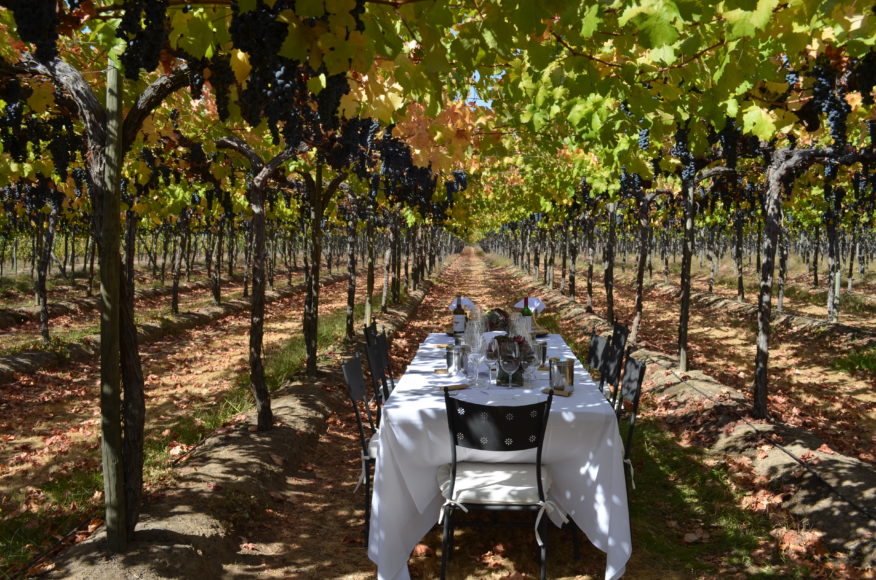Grapes have been grown and wine has been made for centuries in Chile, but it is known as a new-world wine region largely due to its previously unstructured and uninteresting wines. The vines were planted willy-nilly without much respect for location and terroir. Vines were encouraged to push out as much fruit as possible to make as much juice as possible. The political situations of the 1900s were disincentives for investments or development of vineyards and wineries. But today, beginning in the final two decades of the 20th century, this region has been transformed into a respected wine producer.
In the last three decades, the wine world has taken notice of Chile and its capabilities, encouraging talent and money to flow into the Chilean wine industry. Rothschild, Mondavi, Gran Marnier, Aurelio Montes, Paul Hobbs and Michel Rolland are just a few of the alpha names that have embraced the land, the landscape and weather of Chile to craft wines of style and substance, not to mention price tag. Previously, it would be difficult to find a Chilean wine costlier than $20. Today there are hundreds of respectable Chilean wines in the under $20 category, but there are also dozens in the $50 to north of $100 range.
I visited Chile in 2012 for a sponsored full immersion media event in which we traveled north and south from the capital city of Santiago, visiting vineyards and wineries. Chile is a narrow country with its east-west borders essentially defined by the Pacific Ocean and the Andes mountains. And these two boundaries also have a profound effect on grape production. Chile can be hot to very hot and the cooling Pacific influence, along with the altitudes of some of the more westward vineyards in the Andean foothills, contributes to ideal growing conditions for grapes. Hot days, cool nights along with stony, volcanic soils help to create an environment with mineral, organic richness. From these stressing environments, significant hang times of grapes approaching or surpassing 100 days on the vine will create grapes of substance and wines of elegance.
This past week I attended an in-person Chilean wine tasting in a rooftop garden in Brooklyn overlooking the East River and Lower Manhattan. I tasted many of the same wines I had tasted while in Chile and yes, there was a noticeable improvement. As vineyards mature and as roots develop and extend deeper into the soil, the grapes draw a minerality and a complexity from the earth. And deeper roots make the vines more impervious to drought conditions. This large rooftop garden was chosen to highlight the effort Chilean producers have made to be green. Currently 85% of their wine exports are certified sustainable. Many are certified organic or are transitioning in a multiyear effort to sustainable or organic production. In Europe and around the world, phylloxera, an aphid-like grape louse, feeds on the roots of the vines, killing the vineyards. Entire vineyards throughout much of the world have had to be replanted on American rootstock, which is impervious to phylloxera attack. But Chile’s remote setting and physical boundaries have left it unaffected by this devastating pest.
I tasted through many of the wines at this event and found them all to be quite acceptable and many to be exceptional. Find a good wine store with a good inventory and pick up a few bottles from various price points and regions from Chile. They have planted largely noble varieties so most of the grapes grown will all be easily recognizable names. Vista Wine & Spirits in South Salem, The Wine Connection in Pound Ridge and Vintology Wine & Spirits in Scarsdale have a number of these wines in stock. Look for Lapostolle, Cono Sur, Alma Viva, Concha y Toro, Santa Rita, Montes, Koyle, Miguel Torres, Casa Silva and Matetic wines. These are just a few of the sure hits but there are many more. And as the Chilean wine world matures and improves, these will only get better.
And one more consideration: For recent vintages, wines from the Southern Hemisphere get harvested in its autumn (March 20-21 through June 20-21), so these wines are about six months older than Northern Hemisphere wines of the same vintage year. For young wines, this is a considerable percentage of extra maturing time that should lead to a more evolved and comfortable tasting wine in the glass.
Wines of Chile: Pick up a few bottles and share. You will be impressed at every price range. Cheers.
Write me at doug@dougpaulding.com.


